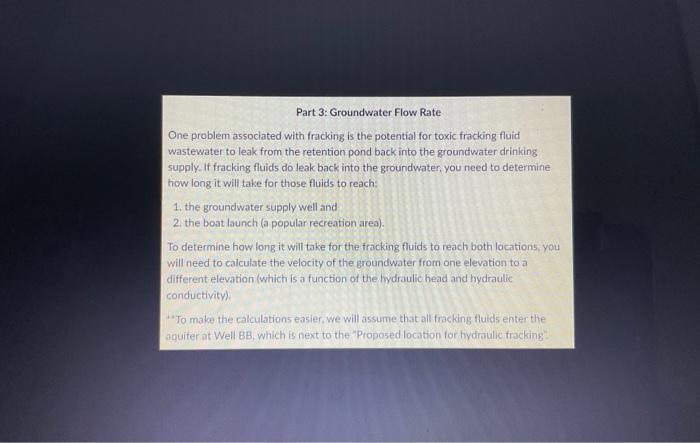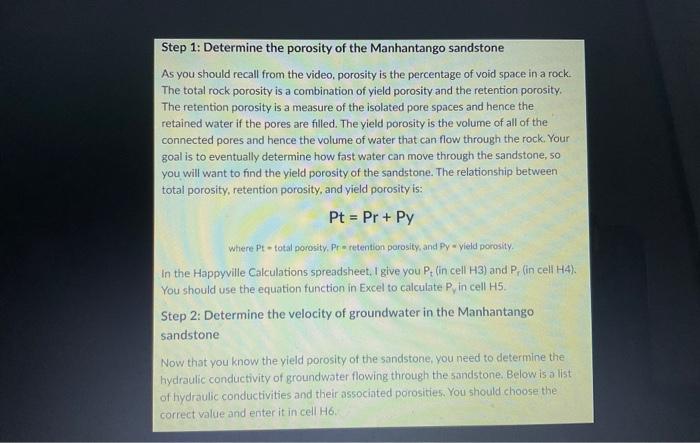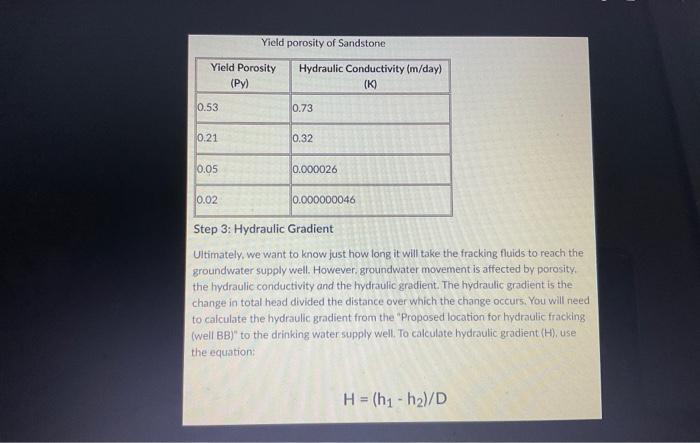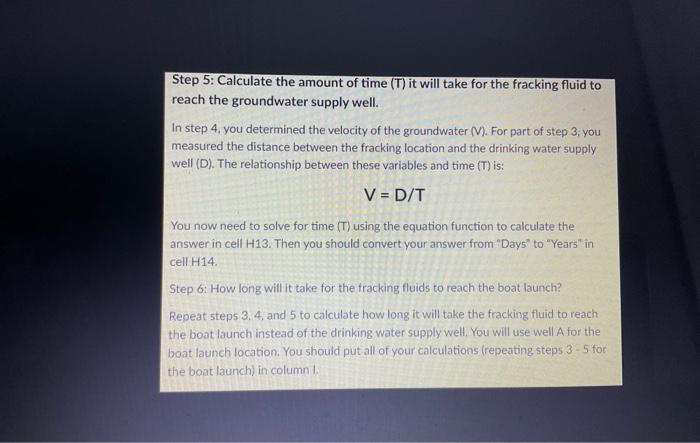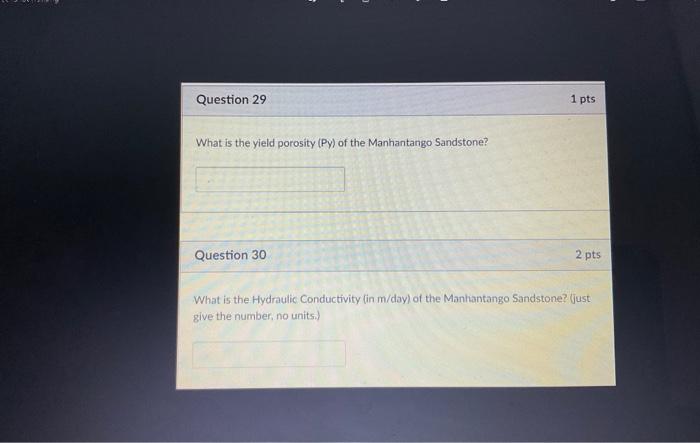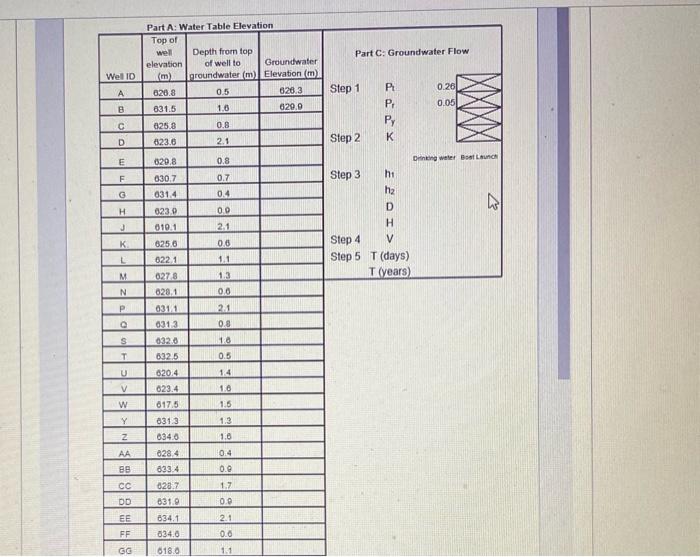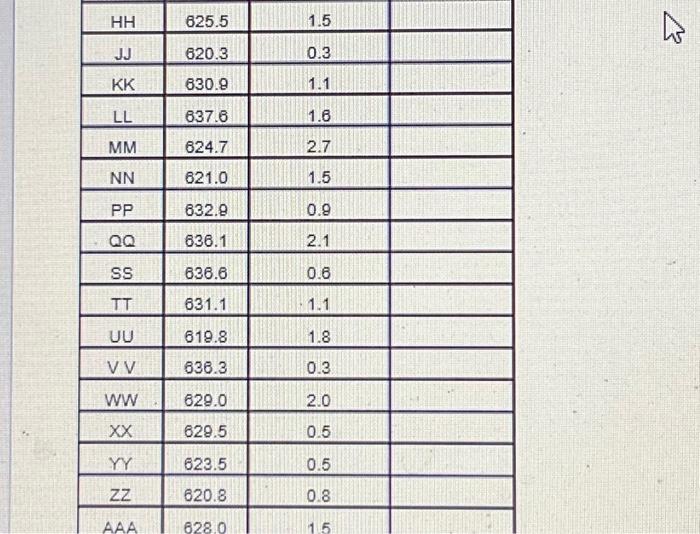Part 3: Groundwater Flow Rate One problem associated with fracking is the potential for toxic fracking fluid wastewater to leak from the retention pond back into the groundwater drinking supply. If fracking fluids do leak back into the groundwater, you need to determine how long it will take for those fluids to reach: 1. the groundwater supply well and 2. the boat launch (a popular recreation area). To determine how long it will take for the fracking fluids to reach both locations, you will need to calculate the velocity of the groundwater from one elevation to a different elevation (which is a function of the hydraulic head and hydraulic conductivity). "To make the calculations easier, we will assume that all fracking fluids enter the aquifer at Well BB, which is next to the "Proposed location for hydraulic fracking": Step 1: Determine the porosity of the Manhantango sandstone As you should recall from the video, porosity is the percentage of void space in a rock. The total rock porosity is a combination of yield porosity and the retention porosity. The retention porosity is a measure of the isolated pore spaces and hence the retained water if the pores are filled. The yield porosity is the volume of all of the connected pores and hence the volume of water that can flow through the rock. Your goal is to eventually determine how fast water can move through the sandstone, 50 you will want to find the yield porosity of the sandstone. The relationship between total porosity, retention porosity, and yield porosity is: Pt=Pr+Py where Pt - total porosity. Pre retention porosity, and Py= yield porosity. In the Happyville Calculations spreadsheet, I give you Pt (in cell H3 ) and Pr (in cell H4). You should use the equation function in Excel to calculate Py in cell H5. Step 2: Determine the velocity of groundwater in the Manhantango sandstone Now that you know the yield porosity of the sandstone, you need to determine the hydraulic conductivity of groundwater flowing through the sandstone. Below is a list. of hydraulic conductivities and their associated porosities. You should choose the correct value and enter it in cell HG. Yield porosity of Sandstone Step 3: Hydraulic Gradient Uitimately, we want to know just how long it will take the fracking fluids to reach the groundwater supply well. However, groundwater movement is affected by porosity. the hydraulic conductivity and the hydraulic gradient. The hydraulic gradient is the change in total head divided the distance over which the change occurs. You will need to calculate the hydraulic gradient from the "Proposed location for hydraulic fracking (well BB)" to the drinking water supply well. To calculate hydraulic gradient (H), use the equation: H=(h1h2)/D - h1 is the groundwater elevation at the proposed fracking location (well BB) - h2 is the groundwater elevation at the drinking water supply well - D is the distance between the well near the "Proposed location for hydraulic fracking" (well BB) and the groundwater supply well. To calculate D, you should use the scale on the map and make sure all of your measurements are in meters! You should place the values of h1,h2, and D in the appropriate cells (H8,H, and H10 in the Excel sheet. Then you should use the equation function in Excel to calculate the hydraulic gradient (H) in cell H11. Step 4: Calculate the pore-water velocity Pore water velocity is a function of the hydraulic conductivity, the hydraulic gradient, and the porosity of the aquifer: V=(K/Pt)H - K is the hydraulic conductivity (cell H6 in your excel sheet) - Pt is the total porosity (cell H3 in your excel sheet) - H is the hydraulic gradient (cell H11 in your excel sheet) You should calculate V using the equation function in Excel and place your answer in cell H12. Step 5: Calculate the amount of time (T) it will take for the fracking fluid to reach the groundwater supply well. In step 4, you determined the velocity of the groundwater (V). For part of step 3; you measured the distance between the fracking location and the drinking water supply well (D). The relationship between these variables and time (T) is: V=D/T You now need to solve for time (T) using the equation function to calculate the answer in cell H13. Then you should convert your answer from "Days" to "Years" in cell H14 Step 6: How long will it take for the fracking fluids to reach the boat launch? Repeat steps 3,4, and 5 to calculate how long it will take the fracking fluid to reach the boat launch instead of the drinking water supply well. You will use well A for the boat launch location. You should put all of your calculations (repeating steps 3 - 5 for the boat launch) in column I. What is the yield porosity (Py) of the Manhantango Sandstone? Question 30 2 pts What is the Hydraulic Conductivity (in m/day) of the Manhantango Sandstone? (just give the number, no units.) Part A: Water Table Elevation \begin{tabular}{|c|c|c|c|} \hline HH & 625.5 & 1.5 & \\ \hline JJ & 620.3 & 0.3 & \\ \hline KK & 630.9 & 1.1 & \\ \hline LL & 637.6 & 1.6 & \\ \hline MM & 624.7 & 2.7 & \\ \hline NN & 621.0 & 1.5 & \\ \hline PP & 632.9 & 0.9 & \\ \hline QQ & 636.1 & 2.1 & \\ \hline SS & 636.6 & 0.6 & \\ \hline TT & 631.1 & 1.1 & \\ \hline UU & 619.8 & 1.8 & \\ \hline VV & 636.3 & 0.3 & \\ \hline WW & 629.0 & 2.0 & \\ \hline XX & 629.5 & 0.5 & \\ \hline YY & 623.5 & 0.5 & \\ \hline ZZ & 620.8 & 0.8 & \\ \hline AAA & 628.0 & 1.5 & \\ \hline \end{tabular} Part 3: Groundwater Flow Rate One problem associated with fracking is the potential for toxic fracking fluid wastewater to leak from the retention pond back into the groundwater drinking supply. If fracking fluids do leak back into the groundwater, you need to determine how long it will take for those fluids to reach: 1. the groundwater supply well and 2. the boat launch (a popular recreation area). To determine how long it will take for the fracking fluids to reach both locations, you will need to calculate the velocity of the groundwater from one elevation to a different elevation (which is a function of the hydraulic head and hydraulic conductivity). "To make the calculations easier, we will assume that all fracking fluids enter the aquifer at Well BB, which is next to the "Proposed location for hydraulic fracking": Step 1: Determine the porosity of the Manhantango sandstone As you should recall from the video, porosity is the percentage of void space in a rock. The total rock porosity is a combination of yield porosity and the retention porosity. The retention porosity is a measure of the isolated pore spaces and hence the retained water if the pores are filled. The yield porosity is the volume of all of the connected pores and hence the volume of water that can flow through the rock. Your goal is to eventually determine how fast water can move through the sandstone, 50 you will want to find the yield porosity of the sandstone. The relationship between total porosity, retention porosity, and yield porosity is: Pt=Pr+Py where Pt - total porosity. Pre retention porosity, and Py= yield porosity. In the Happyville Calculations spreadsheet, I give you Pt (in cell H3 ) and Pr (in cell H4). You should use the equation function in Excel to calculate Py in cell H5. Step 2: Determine the velocity of groundwater in the Manhantango sandstone Now that you know the yield porosity of the sandstone, you need to determine the hydraulic conductivity of groundwater flowing through the sandstone. Below is a list. of hydraulic conductivities and their associated porosities. You should choose the correct value and enter it in cell HG. Yield porosity of Sandstone Step 3: Hydraulic Gradient Uitimately, we want to know just how long it will take the fracking fluids to reach the groundwater supply well. However, groundwater movement is affected by porosity. the hydraulic conductivity and the hydraulic gradient. The hydraulic gradient is the change in total head divided the distance over which the change occurs. You will need to calculate the hydraulic gradient from the "Proposed location for hydraulic fracking (well BB)" to the drinking water supply well. To calculate hydraulic gradient (H), use the equation: H=(h1h2)/D - h1 is the groundwater elevation at the proposed fracking location (well BB) - h2 is the groundwater elevation at the drinking water supply well - D is the distance between the well near the "Proposed location for hydraulic fracking" (well BB) and the groundwater supply well. To calculate D, you should use the scale on the map and make sure all of your measurements are in meters! You should place the values of h1,h2, and D in the appropriate cells (H8,H, and H10 in the Excel sheet. Then you should use the equation function in Excel to calculate the hydraulic gradient (H) in cell H11. Step 4: Calculate the pore-water velocity Pore water velocity is a function of the hydraulic conductivity, the hydraulic gradient, and the porosity of the aquifer: V=(K/Pt)H - K is the hydraulic conductivity (cell H6 in your excel sheet) - Pt is the total porosity (cell H3 in your excel sheet) - H is the hydraulic gradient (cell H11 in your excel sheet) You should calculate V using the equation function in Excel and place your answer in cell H12. Step 5: Calculate the amount of time (T) it will take for the fracking fluid to reach the groundwater supply well. In step 4, you determined the velocity of the groundwater (V). For part of step 3; you measured the distance between the fracking location and the drinking water supply well (D). The relationship between these variables and time (T) is: V=D/T You now need to solve for time (T) using the equation function to calculate the answer in cell H13. Then you should convert your answer from "Days" to "Years" in cell H14 Step 6: How long will it take for the fracking fluids to reach the boat launch? Repeat steps 3,4, and 5 to calculate how long it will take the fracking fluid to reach the boat launch instead of the drinking water supply well. You will use well A for the boat launch location. You should put all of your calculations (repeating steps 3 - 5 for the boat launch) in column I. What is the yield porosity (Py) of the Manhantango Sandstone? Question 30 2 pts What is the Hydraulic Conductivity (in m/day) of the Manhantango Sandstone? (just give the number, no units.) Part A: Water Table Elevation \begin{tabular}{|c|c|c|c|} \hline HH & 625.5 & 1.5 & \\ \hline JJ & 620.3 & 0.3 & \\ \hline KK & 630.9 & 1.1 & \\ \hline LL & 637.6 & 1.6 & \\ \hline MM & 624.7 & 2.7 & \\ \hline NN & 621.0 & 1.5 & \\ \hline PP & 632.9 & 0.9 & \\ \hline QQ & 636.1 & 2.1 & \\ \hline SS & 636.6 & 0.6 & \\ \hline TT & 631.1 & 1.1 & \\ \hline UU & 619.8 & 1.8 & \\ \hline VV & 636.3 & 0.3 & \\ \hline WW & 629.0 & 2.0 & \\ \hline XX & 629.5 & 0.5 & \\ \hline YY & 623.5 & 0.5 & \\ \hline ZZ & 620.8 & 0.8 & \\ \hline AAA & 628.0 & 1.5 & \\ \hline \end{tabular}
